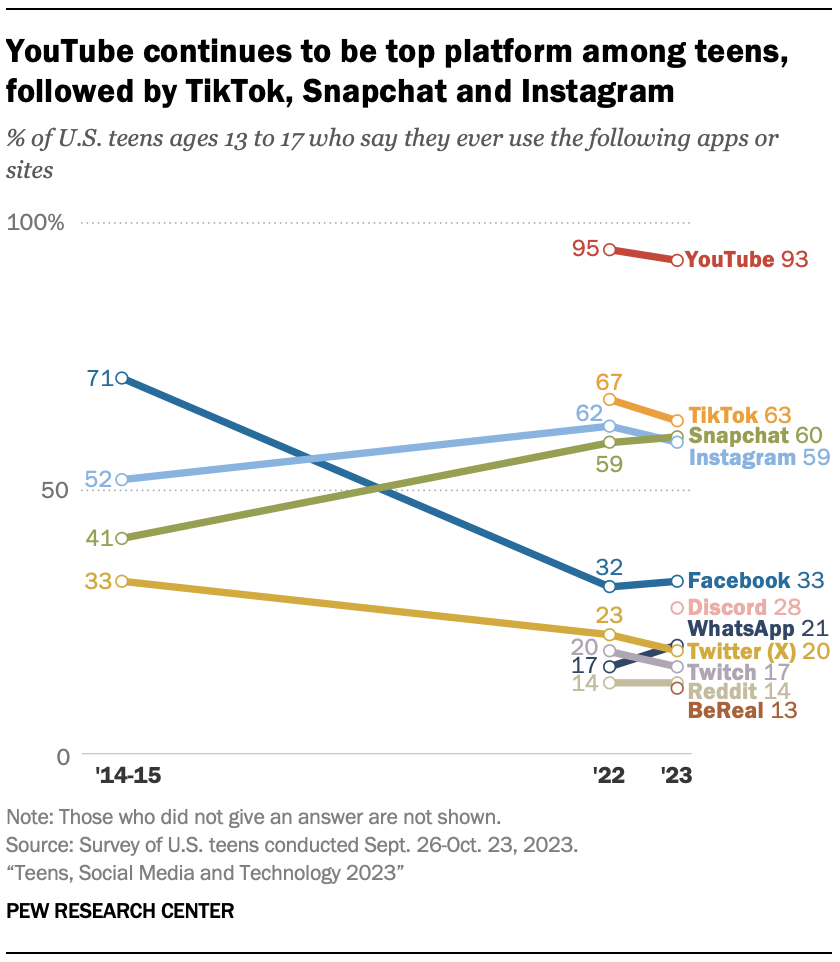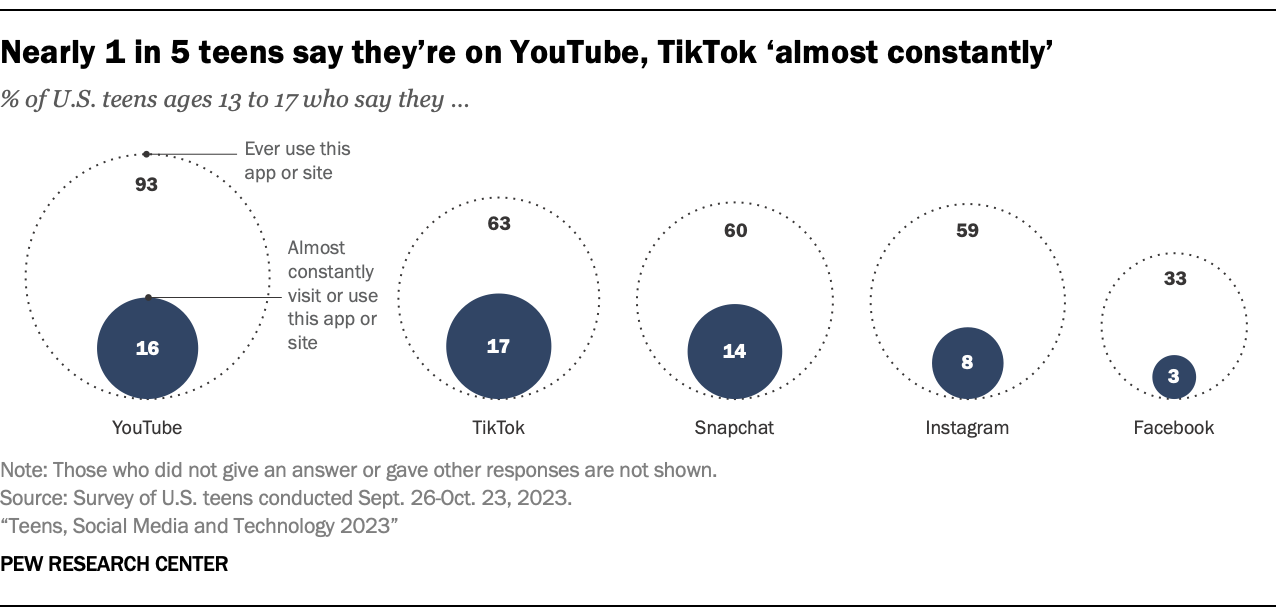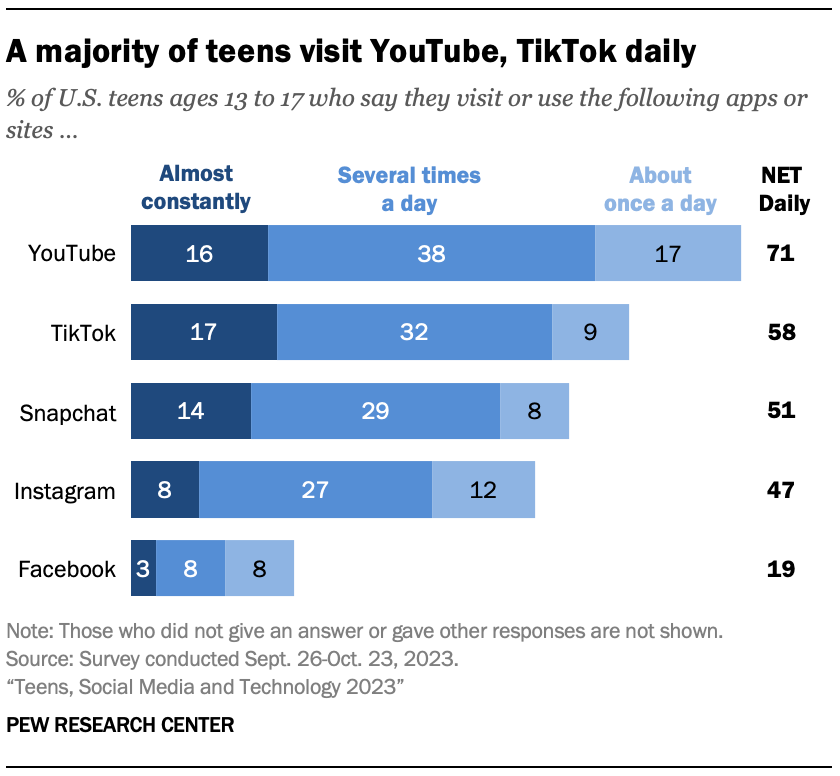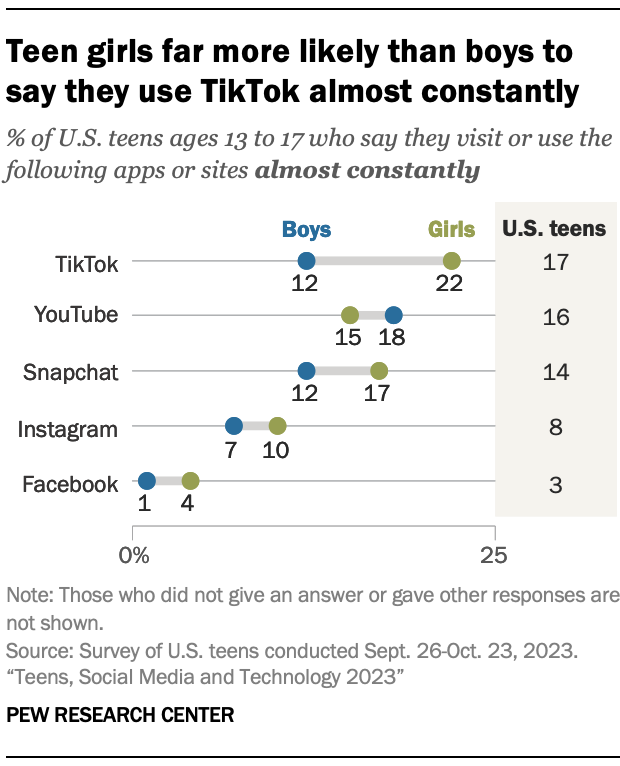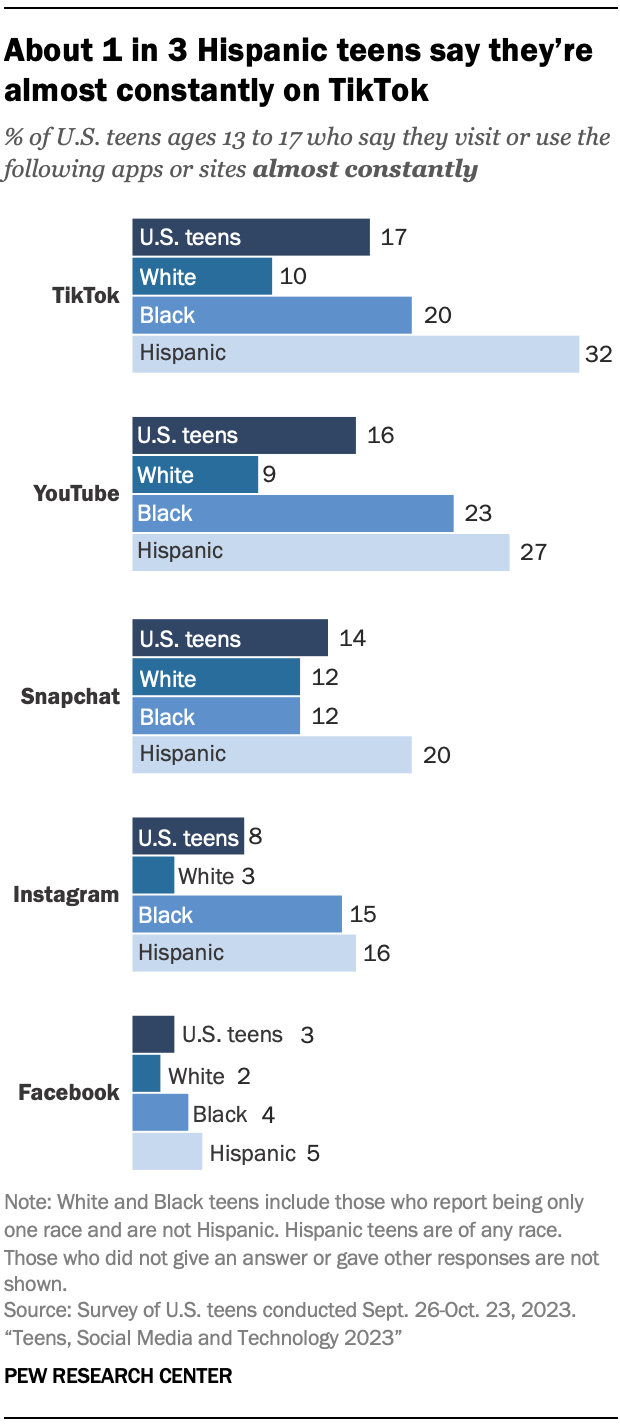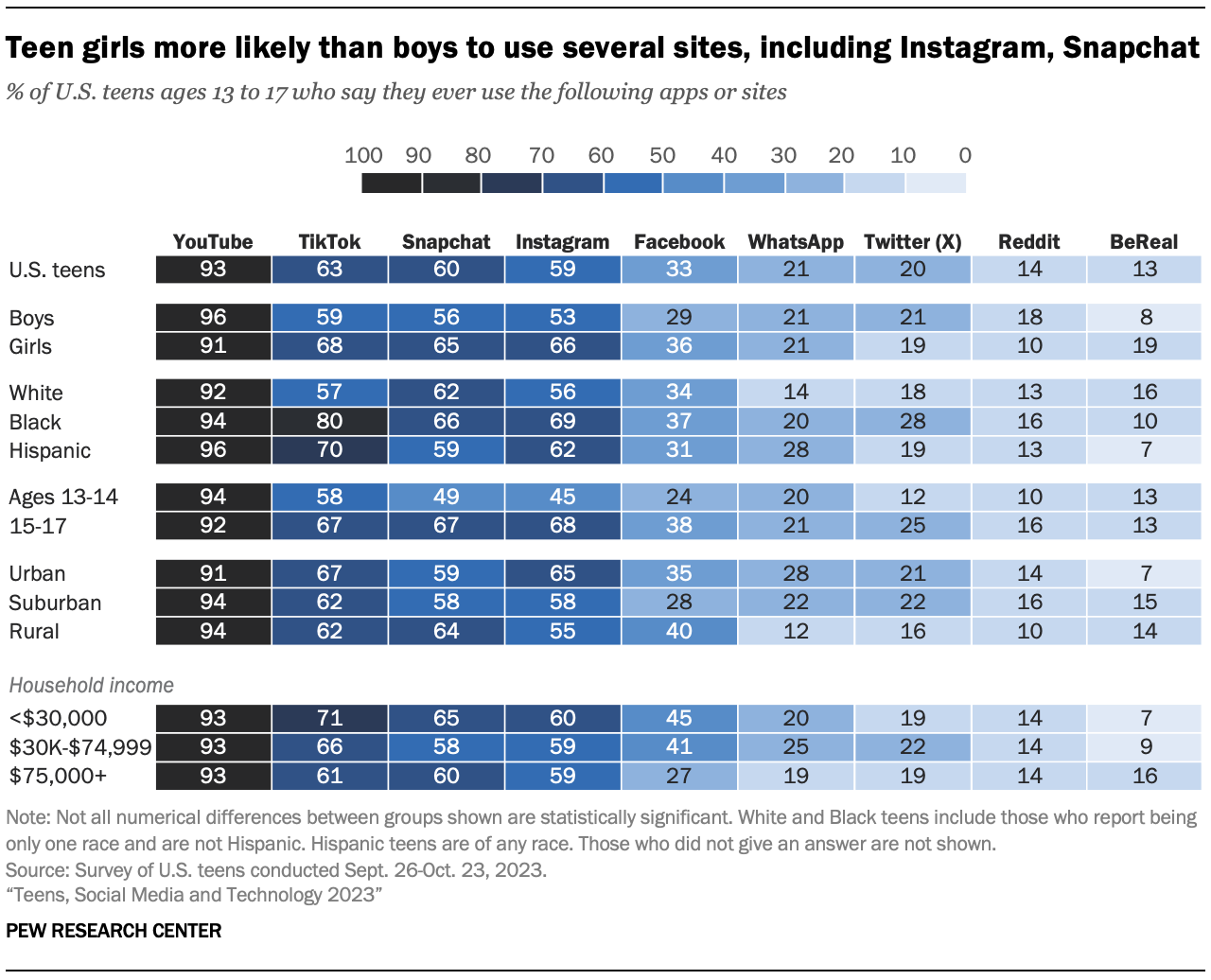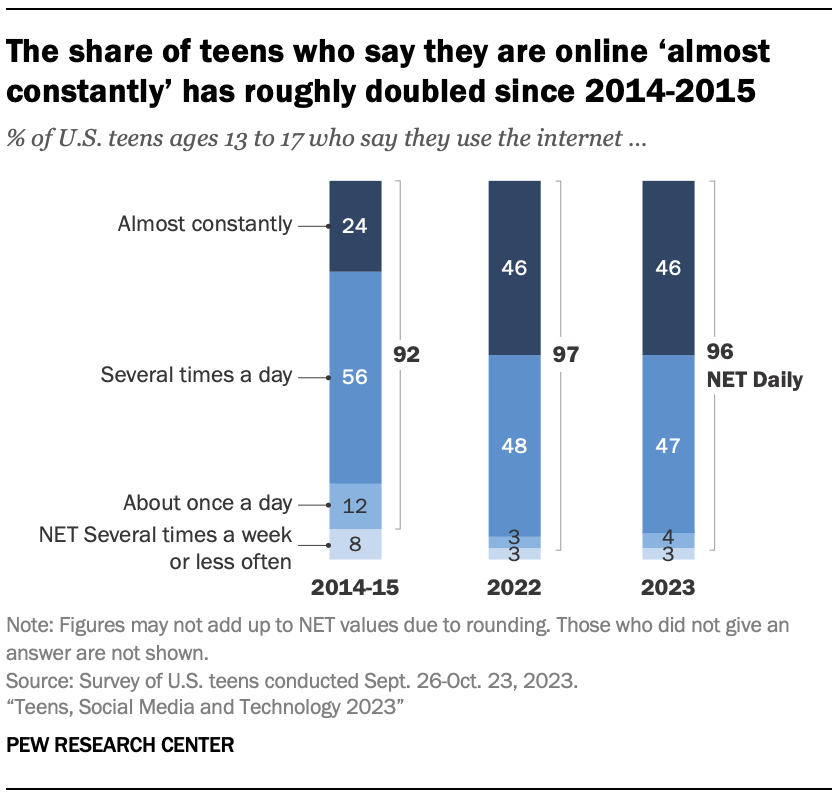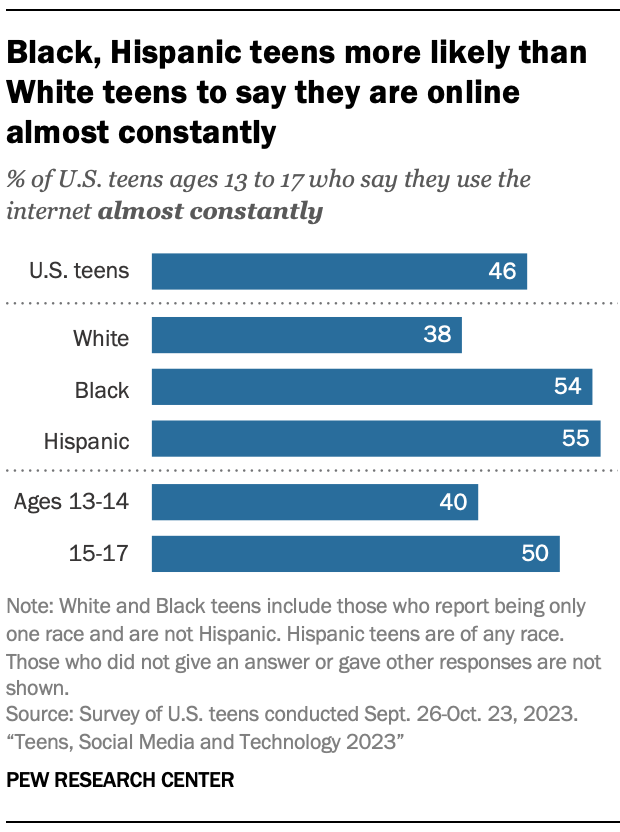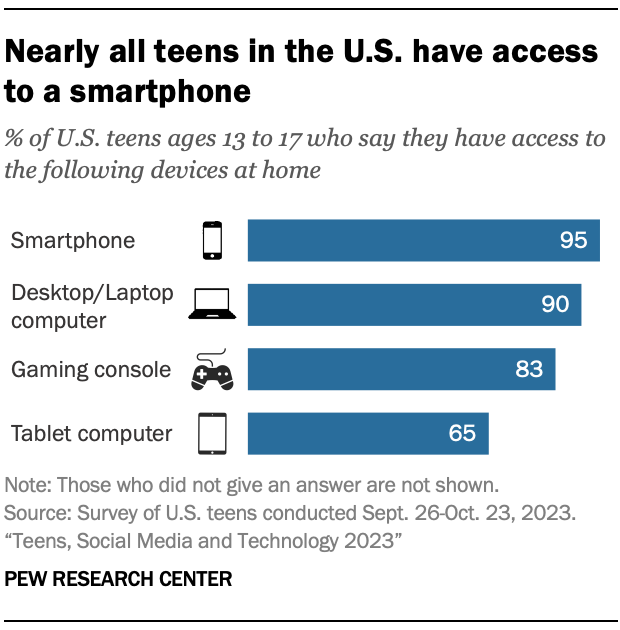Teens, Social Media and Technology 2023 (original) (raw)
YouTube, TikTok, Snapchat and Instagram remain the most widely used online platforms among U.S. teens
(Xavier Lorenzo/Getty Images)
Pew Research Center conducted this study to better understand teens’ use of digital devices, social media and other online platforms.
The Center conducted an online survey of 1,453 U.S. teens from Sept. 26 to Oct. 23, 2023, through Ipsos. Ipsos recruited the teens via their parents, who were part of its KnowledgePanel. The KnowledgePanel is a probability-based web panel recruited primarily through national, random sampling of residential addresses. The survey was weighted to be representative of U.S. teens ages 13 to 17 who live with their parents by age, gender, race and ethnicity, household income, and other categories.
This research was reviewed and approved by an external institutional review board (IRB), Advarra, an independent committee of experts specializing in helping to protect the rights of research participants.
Here are the questions used for this analysis, along with responses, and its methodology.
A note on terminology: Our September-October 2023 survey asked about “Twitter (recently renamed to ‘X’).” The terms Twitter and X are both used in this report to refer to the same platform.
For the latest survey data on social media and tech use among teens, see “Teens, Social Media, and Technology 2024.”
Despite negative headlines and growing concerns about social media’s impact on youth, teens continue to use these platforms at high rates – with some describing their social media use as “almost constant,” according to a new Pew Research Center survey of U.S. teens.
The survey – conducted Sept. 26-Oct. 23, 2023, among 1,453 13- to 17-year-olds – covered social media, internet use and device ownership among teens.
Here’s a look at the key findings related to online platforms:
YouTube continues to dominate. Roughly nine-in-ten teens say they use YouTube, making it the most widely used platform measured in our survey.
TikTok, Snapchat and Instagram remain popular among teens: Majorities of teens ages 13 to 17 say they use TikTok (63%), Snapchat (60%) and Instagram (59%). For older teens ages 15 to 17, these shares are about seven-in-ten.
Teens are less likely to be using Facebook and Twitter (recently renamed X) than they were a decade ago: Facebook once dominated the social media landscape among America’s youth, but the share of teens who use the site has dropped from 71% in 2014-2015 to 33% today. Twitter, which was renamed X in July 2023, has also seen its teen user base shrink during the past decade – albeit at a less steep decline than Facebook.
Teens’ site and app usage has changed little in the past year. The share of teens using these platforms has remained relatively stable since spring 2022, when the Center last surveyed on these topics. For example, the percentage of teens who use TikTok is statistically unchanged since last year.
And for the first time, we asked teens about using BeReal: 13% report using this app.
Related:
- Teens and adults weigh in on social media policies aimed at youth
- Where teens and adults stand on banning TikTok
How often do teens visit online platforms?
In addition to asking teens about the types of platforms they use, we also asked them how often they use five specific platforms: YouTube, TikTok, Snapchat, Instagram and Facebook.
YouTube, the most widely used platform measured in the survey, is also frequently visited by its users. About seven-in-ten teens say they visit the video-sharing platform daily, including 16% who report being on the site almost constantly.
At the same time, 58% of teens are daily users of TikTok. This includes 17% who describe their TikTok use as almost constant.
About half of teens use Snapchat and Instagram daily. A somewhat larger share reports using Snapchat almost constantly compared with Instagram (14% vs. 8%).
Far fewer teens say they use Facebook on a daily basis (19%), with only 3% saying they are on the site almost constantly.
Taken together, a third of teens use at least one of these five sites almost constantly – which is similar to what we found last year.
By gender
Teen girls are more likely than boys to say they almost constantly use TikTok (22% vs. 12%) and Snapchat (17% vs. 12%).
But there are little to no differences in the shares of boys and girls who report almost constantly using YouTube, Instagram and Facebook.
By race and ethnicity
We also see differences by race and ethnicity in how much time teens report spending on these platforms.
Larger shares of Black and Hispanic teens report being on YouTube, Instagram and TikTok almost constantly, compared with a smaller share of White teens who say the same.1
Hispanic teens stand out in TikTok and Snapchat use. For instance, 32% of Hispanic teens say they are on TikTok almost constantly, compared with 20% of Black teens and 10% of White teens.
How use of online platforms differs across demographic groups
While some sites are commonly used among all teens, there are some differences by gender, race and ethnicity, age, and household income.
By gender
Teen girls are more likely than teen boys to say they use Instagram (66% vs. 53%). BeReal, TikTok, Snapchat and Facebook also are more commonly used by teen girls.
On the other hand, teen boys are more likely than teen girls to use Discord (34% vs. 22%) and Twitch (22% vs. 11%). Similarly, a larger share of boys than girls use Reddit and YouTube.
By race and ethnicity
Eight-in-ten Black teens report using TikTok, compared with 70% of Hispanic teens and 57% of White teens. Racial and ethnic gaps are also present in use of Twitter: Black teens are more likely than Hispanic or White teens to be Twitter users.
When it comes to WhatsApp, Hispanic teens are more likely than Black or White teens to say they use the messaging platform.
BeReal is the only platform asked about that White teens are more likely to use than Black or Hispanic teens.
By age
Older teens are more likely than younger teens to use many of the platforms asked about, including Instagram, Snapchat, Facebook, Twitter, TikTok and Reddit. For example, while 68% of teens ages 15 to 17 say they use Instagram, this share drops to 45% among teens ages 13 and 14.
By household income
While fewer teens overall are using Facebook, our surveys consistently show that usage remains higher among teens in lower-income households. For example, 45% of teens in households earning less than 30,000ayearsaytheyuseFacebook,comparedwith2730,000 a year say they use Facebook, compared with 27% of those whose annual household income is 30,000ayearsaytheyuseFacebook,comparedwith2775,000 or more.
Income gaps are also present in TikTok use: Larger shares of teens in lower-income households are users compared with those in the highest-income households (71% vs. 61%).
In comparison, BeReal is more commonly used among teens in households earning 75,000ormoreayear.Some1675,000 or more a year. Some 16% of teens in this category say they use this app, compared with about one-in-ten whose annual household income falls below 75,000ormoreayear.Some1675,000.
How much time are teens spending online?
In addition to asking teens about their social media use, we also examined the amount of time they report spending online.
Nearly half of teens say they use the internet “almost constantly.” This is on par with what we found last year, but roughly double the 24% who said this in the 2014-2015 survey.
Overall, more than nine-in-ten say they use the internet at least daily.
By race and ethnicity
As was true in previous Center surveys, the amount of time teens report spending online varies by race and ethnicity.
While 55% of Hispanic and 54% of Black teens report being on the internet almost constantly, the share drops to 38% among White teens.
By age
Older teens ages 15 to 17 are somewhat more likely than younger teens to be near-constant internet users (50% vs. 40%).
Device usage: Smartphones, computers, gaming consoles and tablets
Today’s teens have several ways to go online, connect with others and find information.
Our survey finds that most teens have or have access to a smartphone (95%), a desktop or laptop computer (90%), or a gaming console (83%). A smaller share – though still a 65% majority – say the same for tablets.
By household income
Smartphone ownership is nearly universal among teens of different genders, ages, races and ethnicities, and economic backgrounds. But having access to a home computer remains less common for those in lower-income households.
Roughly seven-in-ten teens living in households earning less than 30,000ayear(7230,000 a year (72%) say they have access to a home computer. That share rises among those whose annual household income is 30,000ayear(7230,000 to 74,999(8774,999 (87%) or 74,999(8775,000 and above (94%).
Tablet ownership is also less common among teens in lower-income households: 57% say they have access to a tablet at home, compared with 67% of those living in the highest-income households.
By gender
Most teen boys and girls report having access to a game console at home, but more boys say this than girls (91% vs. 75%).

